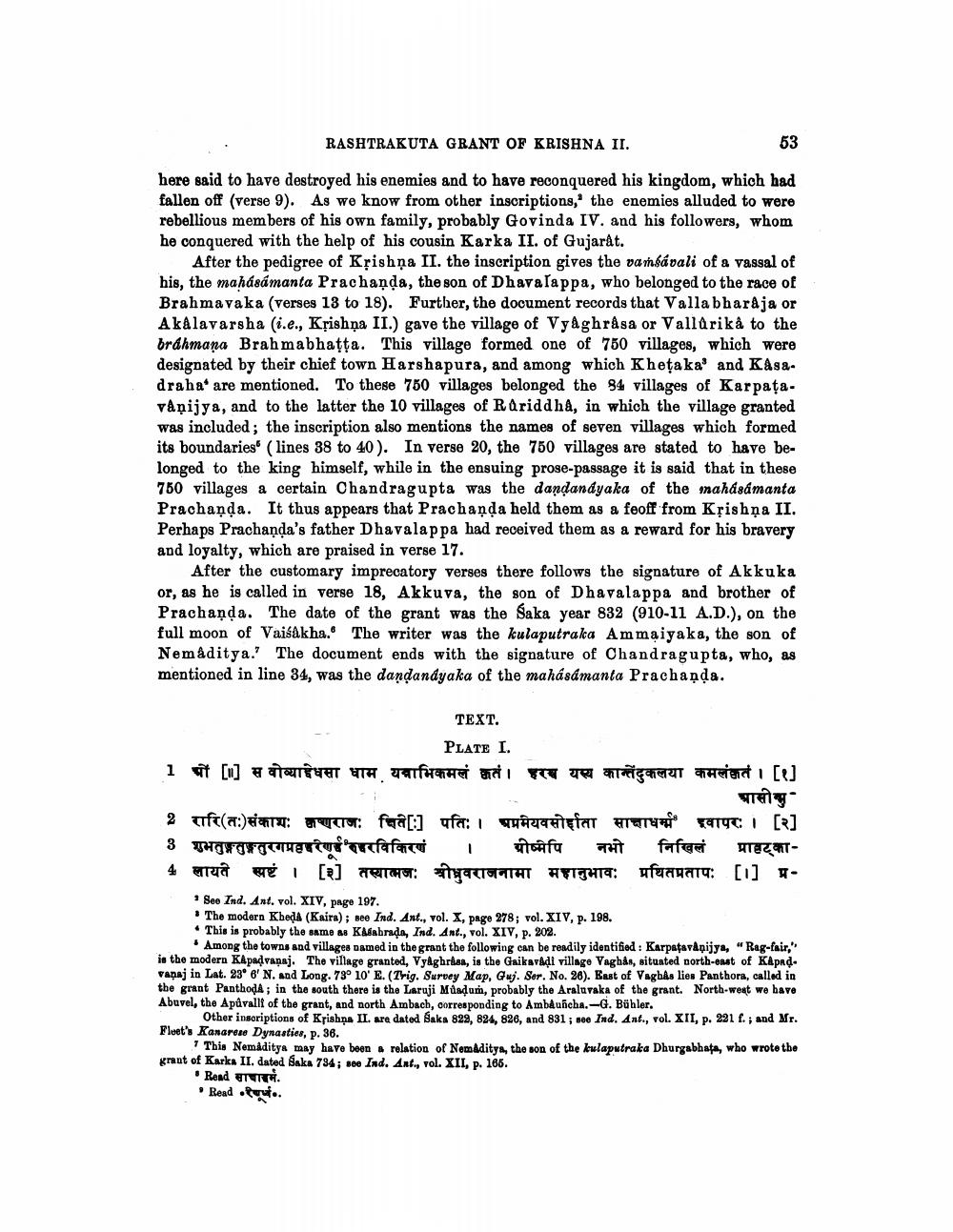________________
RASHTRAKUTA GRANT OF KRISHNA II.
53
here said to have destroyed his enemies and to have reconquered his kingdom, which had fallen off (verse 9). As we know from other inscriptions, the enemies alluded to were rebellious members of his own family, probably Govinda IV. and his followers, whom he conquered with the help of his cousin Karka II. of Gujarat.
After the pedigree of Krishna II. the inscription gives the vamsávali of a vassal of his, the mahásámanta Prachanda, the son of Dhavalappa, who belonged to the race of Brahmavaka (verses 13 to 18). Further, the document records that Vallabharaja or Akalavarsha (i.e., Krishna II.) gave the village of Vyaghrása or Vallarikå to the brahmana Brahmabhatta. This village formed one of 750 villages, which were designated by their chief town Harshapura, and among which Khetaka and Kasadrahaare mentioned. To these 750 villages belonged the 84 villages of Karpaţa.
Aniiya, and to the latter the 10 villages of Rariddha, in which the village granted was included; the inscription also mentions the names of seven villages which formed its boundaries (lines 38 to 40). In verse 20, the 750 villages are stated to have belonged to the king himself, while in the ensuing prose-passage it is said that in these 750 villages a certain Chandragupta was the dandandyaka of the mahasamanta Prachanda. It thus appears that Prachanda held them as a feoff from Kệishņa II. Perhaps Prachanda's father Dhavalappa had received them as a reward for his bravery and loyalty, which are praised in verse 17.
After the customary imprecatory verses there follows the signature of Akkuka or, as he is called in verse 18, Akkuva, the son of Dhavalappa and brother of Prachanda. The date of the grant was the Saka year 832 (910-11 A.D.), on the full moon of Vaisakha. The writer was the kulaputraka Ammaiyaka, the son of Nemaditya.' The document ends with the signature of Chandragupta, who, as mentioned in line 34, was the dandandyaka of the mahásdmanta Prachanda.
TEXT.
PLATE I. i ot Cu T ET UTH. HET I e arrecariet Heiert [2]
wey 2 aft(a) : cror: fwa[:] ufa: 1 W 1441fAT HIU TYC 1 [R] 3 शुभतुङ्गतुङ्गतुरगप्रहहरेणई सहरविकिरणं । ग्रीष्मपि नभो निखिलं प्राहका4 rua n [x] IC:
THT #FITHTA: ufugeatu: [1] 4
* See Ind. Ant. vol. XIV, page 197. * The modern KhedA (Kaira); see Ind. Ant., vol. X, pago 278; vol. XIV, p. 198. * This is probably the same as Kalabrado, Ind. Ant., vol. XIV, p. 202.
Among the towns and villages named in the grant the following can be readily identified: Karpatavanijya, "Rag-fair," in the modern Kapadvanaj. The village granted, Vyaghrása, is the Gaikaval village Vaghas, situated north-east of Kapad. vanaj in Lat. 23° 6' N. and Long. 79° 10' E. (Trig. Survey Map, Guj. Ser. No. 26). East of Vagbas lies Panthora, called in the grant Panthod; in the south there is the Laruji Müadum, probably the Araluvaka of the grant. North-west we have Abuvel, the Apůvallt of the grant, and north Ambach, corresponding to Ambducha.-G. Bühler.
Other inscriptions of Krishna II. are dated Saka 822, 824, 826, and 831; see Ind. Ant., vol. XII, p. 221 f.; and Mr. Fluet's Kanareae Dynasties, p. 36.
This Nemåditys may have been relation of Nemaditys, the son of the kulaputraka Dhurgabhata, who wrote the grant of Karka II. dated Šaka 734; see Ind. Ant., vol. XII, p. 165.
• Read ETVICA. . Read .out..




